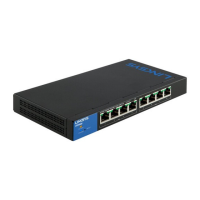53
Table of Contents
Linksys
53
Chapter 8 MAC Address
Management
MAC Address Management
This section describes how to add MAC addresses to the system. It covers the
following topics:
• Dynamic MAC Addresses
• Static MAC Addresses
• Reserved MAC Addresses
There are two types of MAC addresses—static and dynamic. Depending on
their type, MAC addresses are either stored in the Static Address table or in
the Dynamic Address table, along with VLAN and port information.
Static addresses are configured by the user, and therefore, they do not expire.
A new source MAC address that appears in a frame arriving at the device
is added to the Dynamic Address table. This MAC address is retained for a
configurable period of time. If another frame with the same source MAC
address does not arrive at the device before that time period expires, the MAC
entry is aged (deleted) from the table.
When a frame arrives at the device, the device searches for a corresponding/
matching destination MAC address entry in the static or dynamic table. If a
match is found, the frame is marked for egress on the port specified in the
table. If frames are sent to a MAC address that is not found in the tables, they
are transmitted/broadcasted to all the ports on the relevant VLAN. Such
frames are referred to as unknown Unicast frames.
The device supports a maximum of 8K static and dynamic MAC addresses.
Dynamic MAC Addresses
The Dynamic Address Table (bridging table) contains the MAC addresses
acquired by monitoring the source addresses of frames entering the device.
To prevent this table from overflowing, and to make room for new MAC
addresses, an address is deleted if no corresponding traffic is received for a
certain period. This period of time is the aging interval.
Configuring Dynamic MAC Address Aging Time
To configure the aging interval for dynamic addresses, do the following:
STEP 1 Click Configuration > MAC Address Management > Dynamic
MAC Addresses.
STEP 2 Enter Aging Time. The aging time is a value between the user-
configured value and twice that value minus 1. For example, if
you entered 300 seconds, the aging time is between 300 and 599
seconds.
STEP 3 Click Apply. The aging time is updated.To query dynamic addresses,
do the following:
STEP 4 In the Dynamic MAC Address Table block, enter the query criteria:
• VLAN ID—Enter the VLAN ID for which the table is queried.
• MAC Address—Enter the MAC address for which the table is queried.
• Interface—Select the interface for which the table is queried. The query
can search for specific unit/slot, ports, or LAGs.
• Sort By—Select the field for which the table is queried.
STEP 5 Click Search. The Dynamic MAC Address Table is queried and the
results are displayed.To delete all dynamic MAC addresses click Clear.
Static MAC Addresses
Static MAC addresses are assigned to a specific physical interface and VLAN
on the device. If that address is detected on another interface, it is ignored,
and is not written to the address table.
To define a static address:
STEP 1 Click Configuration > MAC Address Management > Static MAC
Addresses.
The Static Addresses page contains the currently defined static addresses.
STEP 2 Click Add.
STEP 3 Enter the parameters.
• VLAN ID—Select the VLAN ID for the port.

